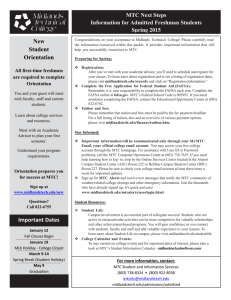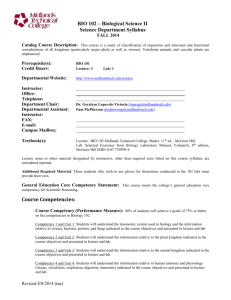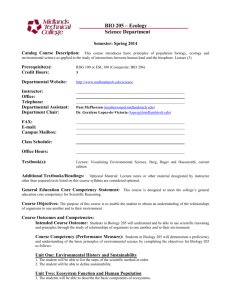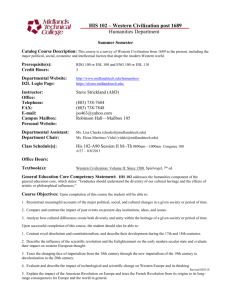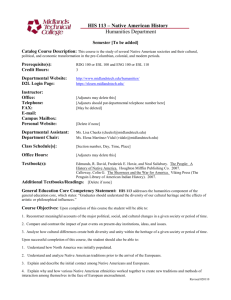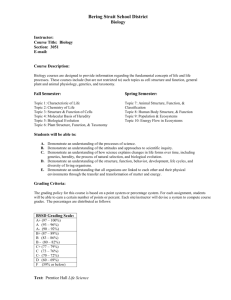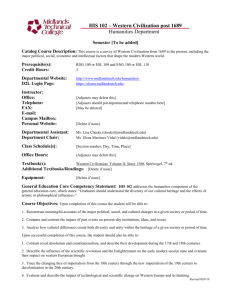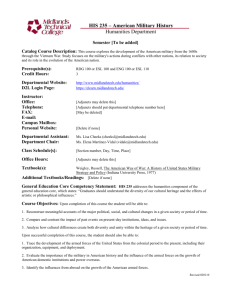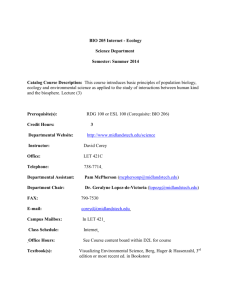BIO 101 syllabus - Midlands Technical College
advertisement
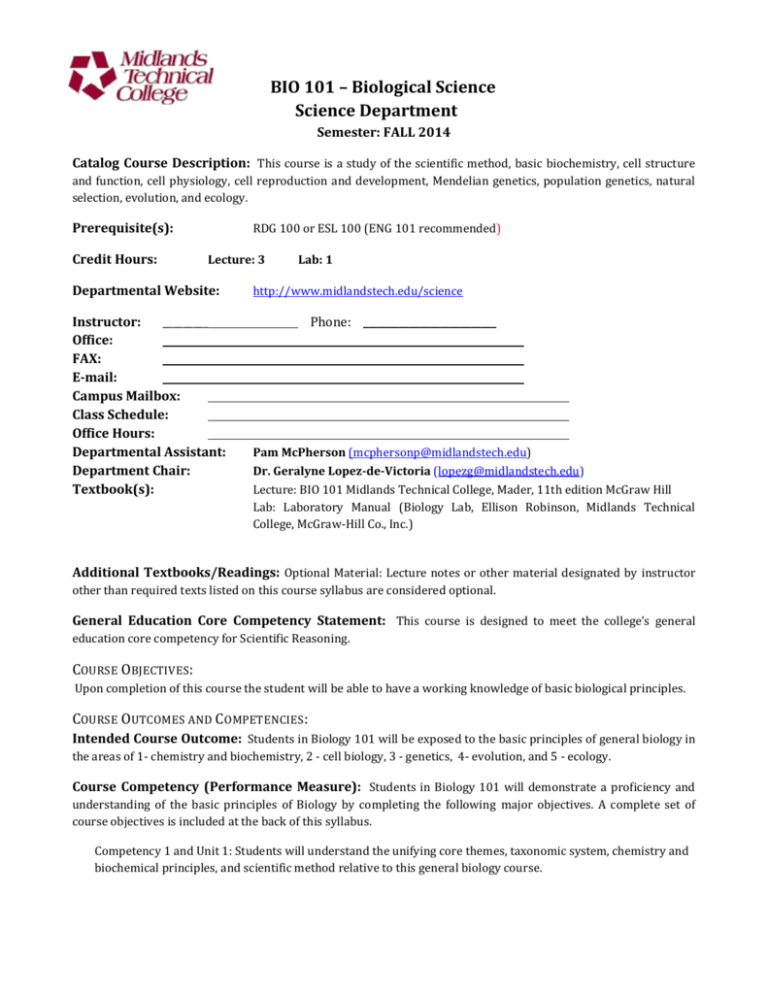
BIO 101 – Biological Science Science Department Semester: FALL 2014 Catalog Course Description: This course is a study of the scientific method, basic biochemistry, cell structure and function, cell physiology, cell reproduction and development, Mendelian genetics, population genetics, natural selection, evolution, and ecology. Prerequisite(s): Credit Hours: RDG 100 or ESL 100 (ENG 101 recommended) Lecture: 3 Departmental Website: Instructor: _________ Office: FAX: E-mail: Campus Mailbox: Class Schedule: Office Hours: Departmental Assistant: Department Chair: Textbook(s): Lab: 1 http://www.midlandstech.edu/science Phone: __________________________ Pam McPherson (mcphersonp@midlandstech.edu) Dr. Geralyne Lopez-de-Victoria (lopezg@midlandstech.edu) Lecture: BIO 101 Midlands Technical College, Mader, 11th edition McGraw Hill Lab: Laboratory Manual (Biology Lab, Ellison Robinson, Midlands Technical College, McGraw-Hill Co., Inc.) Additional Textbooks/Readings: Optional Material: Lecture notes or other material designated by instructor other than required texts listed on this course syllabus are considered optional. General Education Core Competency Statement: This course is designed to meet the college’s general education core competency for Scientific Reasoning. COURSE OBJECTIVES : Upon completion of this course the student will be able to have a working knowledge of basic biological principles. COURSE OUTCOMES AND COMPETENCIES : Intended Course Outcome: Students in Biology 101 will be exposed to the basic principles of general biology in the areas of 1- chemistry and biochemistry, 2 - cell biology, 3 - genetics, 4- evolution, and 5 - ecology. Course Competency (Performance Measure): Students in Biology 101 will demonstrate a proficiency and understanding of the basic principles of Biology by completing the following major objectives. A complete set of course objectives is included at the back of this syllabus. Competency 1 and Unit 1: Students will understand the unifying core themes, taxonomic system, chemistry and biochemical principles, and scientific method relative to this general biology course. Competency 2 and Unit 2: Students will understand the principles of cell biology, photosynthesis, and cellular respiration relative to this general biology course. Competency 3 and Unit 3: Students will understand the principles of Mendelian and human genetics and the role of DNA and RNA in protein synthesis relative to this general biology course. Competency 4 and Unit 4: Students will understand the principles of evolution and natural selection and the biological view of the origin of life relative to this general biology course. Competency 5 and Unit 5: Students will understand the principles of ecology relative to this general biology course. Measurement Instrument: Students in Biology 101 will indicate successful completion of these objectives by completing a set of examinations. Program- and course-assessment activities are deployed and results collected in accordance with the College’s assessment schedule. Refer to the information in the syllabus regarding the applicability of assessment activity for the current semester. Course Attendance: Students may miss twice the number of times a lecture or laboratory section meets per week. o o o o o If the lecture meets 3 times per week, 6 absences are allowed. If the lecture meets 2 times per week, 4 absences are allowed. If the laboratory meets once a week, 2 absences are allowed. If the student misses more than 10 minutes of class by either arriving late or leaving early, the student will be counted absent, Missing fewer than 10 minutes is a tardy. Three tardies count as one absence. Students adding courses after classes begin are responsible for work covered from the first day of class. All classes missed count as absences. *** YOU (the student) are responsible for all material and announcements presented in the lecture sessions, whether or not you are present. Withdrawal: Students may withdraw from a course any time before the last week of classes (see the current semester college calendar, available on the MTC web site, for official dates). Students who wish to withdraw from a course must submit a withdrawal form to records. The date of withdrawal may affect a number of things, including financial aid/ tuition reimbursement, tuition refunds, and course grades. The effective date of withdrawal depends upon the date the withdrawal form is submitted to records. It is the student’s responsibility to be aware of relevant dates, to make an informed decision, and if necessary, to submit withdrawal forms in a timely fashion. For questions regarding the effect of withdrawal on financial aid or tuition reimbursement students should contact Student Financial Services. Deadlines for tuition refunds may be found on the current semester college calendar, available on the MTC web site, or by calling the cashier’s office. Students who withdraw before midterm will receive a grade of W. Students who withdraw after midterm and have an overall class average of 60% or greater will receive a grade of W. Students who withdraw after midterm and have an overall class average below 60% will receive a grade of WF, which is calculated as an F. Revision of 2/9/2016 2 Grades of W or WF are also assigned when a student exceeds the maximum number of absences allowed in a course. These grades are entered on the final grade roster along with the last date of attendance (LDA). Students should understand that the LDA does not constitute an effective date of withdrawal and should not consider a decision to stop attending class to be equivalent to withdrawal. Course Grading Scale: The final grade for this course will be determined as follows: A (90-100) B (80-89) C (70-79) D (60-69) F (<60) The Lecture Grade is 75% of the overall grade for the course and results from any exams, homework, pop-quizzes, and/or outside work assigned by the instructor. The Lab grade is 25% of the overall grade for the course and derives from lab quizzes, lab practicals, lab-activity completion grades, homework, and other material assigned by the instructor. A grade of zero will be recorded for any announced exam (or assignment), which is missed. The Instructor will indicate whether one lecture exam can be made up or whether the cumulative final exam will count twice in place of the missed exam. PLEASE NOTE: The instructors reserve the right to adjust the requirements, pace, or scheduling of this course. Any change will be announced in class before it becomes effective. The faculty, coordinators and Science Department Chair are here to assist you. If you are having any difficulty with your class please talk to your instructor. After you have addressed your concerns with your instructor, you may wish to discuss them with the Science Coordinator for your campus. Dr. Gregory Mancini (738-7660) is Beltline Science Coordinator. Airport Science Coordinator is Mr. Tom Abrahamsen (822-3549). The Northeast Campus Science Coordinator is Dr. Ellison Robinson (691-3919). Finally, you may speak with the Department Chair, if necessary. Dr. Geralyne Lopez-de-Victoria is Department Chair. You may reach the Dep’t. Chair by calling Pam McPherson (Departmental Assistant), at 822-3548. LABORATORY POLICIES AND SAFETY PRECAUTIONS The laboratory is an integral part of the course. It supplements and complements material covered in lecture. Material may be presented in greater detail in lab than in lecture. The laboratory experience may include dissections, films, demonstrations, experiments, workbook exercises, research and writing assignments, and field trips. Approved field trips will occur, normally, during regularly scheduled lab periods. Students will provide their own transportation. Laboratory instructors will provide sufficient information and guidance to allow students to complete each lab, but success in lab primarily involves the individual effort of each student. To maximize learning and to minimize the risk of accidents or injury, the following policies and rules will be observed in science labs: 1. 2. 3. 4. 5. Students should read laboratory exercises before coming to class. Laboratory exercises must be completed during the assigned lab period, unless otherwise designated by your instructor. Do not disturb any equipment or demonstrations that have been set up until your instructor has told you how to proceed with the assignment. Apply yourself in lab. The exercises are designed to reinforce and expand upon material presented in the lecture. Follow directions carefully. Revision of 2/9/2016 3 6. 7. 8. 9. 10. 11. 12. 13. 14. Do not hesitate to ask your lab instructor for clarification of any instructions you do not understand. However, do not expect your lab instructor to simply give you answers to information you should be obtaining through the completion of the various lab exercises. Bring all necessary materials to class, including your text. Do not bring any food or drinks into any science lab. Know where the eyewash station and shower are located in each lab. Report injuries immediately to your lab instructor. Protective eyewear may be required in some labs. Students should have a set of goggles or safety glasses to wear during specified experimental procedures. Open-toed footwear is a safety hazard. Such footwear is not allowed to be worn in the lab. While in the lab, students must wear shoes that completely cover their feet at all times. Failure to wear proper footwear and eye safety equipment (when required) will result in dismissal from the lab for the day. At the end of each lab, leave your work space in good order by discarding waste materials, cleaning and disinfecting your lab table, returning all materials used to their proper place, and sliding your chair back under the table No visitors will be allowed lab or lecture sessions. BIO 101 LECTURE INFORMATION WEEK ACTIVITY CHAPTER A View of Life 1 Basic Chemistry 2 Week 2 Basic Chemistry (Concluded) 2 Week 3 The Chemistry of Organic Molecules 3 Week 1 (EXAM 1) Exam 1 Cell Structure and Function Week 4 4 Membrane Structure and Function The Cell Cycle and Cellular Reproduction Week 5 Week 6 (EXAM 2 Week 7 Week 8 Revision of 2/9/2016 Chapters 1-3 5 9 Metabolism: Energy and Enzymes Photosynthesis 6 7 Cellular Respiration 8 Exam 2 Chapters 4, 5, 6, 7, 8, 9 Meiosis and Sexual Reproduction 10 Mendelian Patterns of Inheritance 11 Molecular Biology of the Gene 12 Regulation of Gene Expression 13 4 BIO 101 LECTURE INFORMATION (Selected topics) Week 9 (EXAM 3) Human Genetics (from Ch-11) 11 Biotechnology and Genomics (Selected topics) 14 Exam 3 Chapters 10-14 Origin and History of Life 18 Darwin and Evolution 15 How Populations Evolve 16 Speciation and Macroevolution 17 Human Evolution (selected topics) 30 Week 12 Exam 4 Chapters 15, 16, 17, 18, 30 (EXAM 4) Population Ecology 44 Community and Ecosystem Ecology 45 Major Ecosystems of the Biosphere 46 Week 10 Week 11 Week 13 Week 14 (EXAM 5) Exam 5 Chapters 44, 45, 46 Course Review (if time permits) Final Exam Cumulative Week 15 Units 1-5 (See course objectives in Syllabus) Revision of 2/9/2016 5 BIO 101 LAB INFORMATION WEEK Week 1 Week 2 EXERCISE TOPIC Welcome (pg. 2) Intro, Syllabus and Safety rules Exercise 1 (pg. 9) Scientific method Exercise 2 (pg. 19) Measurements in Biology Exercise 3 (pg. 29) The Microscope Quiz 1 Week 3 Week 4 Exercise 5 (pg. 41) Solutions, Acids, and Bases Exercise 6 (pg. 49) Biologically Important Molecules Exercise 12 (pg. 63) Microbiology Exercise 4 (pg. 79) The Cell: Structure and Function Quiz 2 Week 5 Exercise 9 (pg. 95) Diffusion and Osmosis Exercise 14 (pg. 107) Mitosis Exercise 6 (pg. 127) Week 6 Note order reversal Exercise 8 (pg. 117) Enzymes Photosynthesis Quiz 3 Week 7 Exercise 7 (pg. 137) Cellular Respiration Exercise 15 (pg. 143) Meiosis Exercise 17 (pg. 155) Genetics Exercise 10 (pg. 169) Genetics Counseling Week 9 Quiz 4, Exercise 9 (pg. 185) DNA Biology and Technology Week 10 Exercise 12 (pg. 199) Evidences of Evolution Week 11 Quiz 5, Exercise 13 (pg. 215) Natural Selection Week 12 Exercise 22 (pg. 225) Exercise 30 (pg. 233) Population Growth Symbiotic Relationships Week 13 Quiz 6 Student Reports Biomes Week 14 Student Reports (cont’d) Biomes Week 8 Revision of 2/9/2016 6 COURSE OBJECTIVES - LECTURE Students will be able to complete the following by the end of this course: UNIT 1: INTRODUCTION AND CHEMISTRY (1) Give specific examples and describe the structure and role in human nutrition of the following molecules: (a) carbohydrates (monosaccharides, disaccharides, polysaccharides); lipids (triglycerides and steroids); proteins; nucleic acids (DNA and RNA). (2) Describe the structure of the water molecule and relate the polar covalent nature of water to the following properties: cohesion, adhesion, high specific heat, excellent evaporative coolant, excellent solvent. (3) Define taxonomy and compare the five major kingdoms (Prokaryotae, Protista, Fungi, Plant, and Animal) based on nutrition (heterotroph/ autotroph), cell type (prokaryotic/ eukaryotic), and types of organisms present in each kingdom. (4) Describe the improvements made by Carolus Linnaeus to the existing taxonomic system. List the major taxa in order: Kingdom, phylum, class, order , family, genus, species (5) Define atomic number and atomic weight and use these to predict the electron configuration and type of ion for the following elements: sodium, chlorine, carbon, hydrogen. (6) Define and contrast in terms of strength ionic, covalent, and hydrogen bonds and give examples of several molecules formed from each (7) Describe the steps in the Scientific Method: a. identifying a problem, forming a hypothesis, developing an experiment, collecting data, forming a conclusion, communicating results. (8) Define what is meant by hypothesis, data, sample size and control group and give the significance of each to an acceptable scientific method. UNIT 2: CELL BIOLOGY, P HOTOSYNTHESIS, RESPIRATION (1) Differentiate between a prokaryotic and a eukaryotic cell and indicate which type of cell members of the following kingdoms would be composed: Prokaryotae, Protista, Fungi, Plant, and Animal (2) Describe the structure and function of the following cell organelles and structures: nucleus, nucleolus, chromatin, mitochondrion, chloroplast, lysosomes, rough and smooth endoplasmic reticulum, vacuoles, Golgi apparatus, ribosomes, cytoskeleton, cell membrane, nuclear membrane (3) Describe the structure of the cell membrane based on the fluid-mosaic model including the role that phospholipids and proteins play. Define selectively permeable. (4) Describe the major steps and products of the light and light-independent (Calvin Cycle) reactions of photosynthesis. Define photosystem I, photosystem II, chloroplast, chlorophyll. State which wavelengths of light are used directly by the chlorophyll molecule. (5) Give the reactants and products in a summarized equation for photosynthesis. (6) State the number of ATP molecules produced in Glycolysis, Krebs cycle, and Electron Transport Chain and state where each reaction takes place in the cell. (7) Describe the following type of cell transport: diffusion, osmosis, facilitated diffusion, active transport, phagocytosis (endocytosis) giving an example of how each is used in the body. Revision of 2/9/2016 7 (8) List three differences between plant and animal cells. (9) Describe the major events taking place in each stage of mitosis: interphase, prophase, metaphase, anaphase, and telophase. Define mitotic spindle (spindle fibers), metaphase plate (equator), cytokinesis. (10) Define enzyme and substrate and give five characteristics of enzymes based on 1. specificity, 2. ability to alter the rate of reaction, 3. chemical nature (protein), 4. ability to be used many times to catalyze same reaction, and 5. the induced fit mechanism. Describe the effects that changing pH, enzyme concentration, and temperature will have on the ability of an enzyme to work and the rate of reaction. UNIT 3: GENETICS AND P ROTEIN SYNTHESIS (1) Perform genetics problems related to monohybrid, dihybrid, sex-linked traits, and incomplete dominance indicating the phenotypic and genotypic ratios for the F1 generation. (2) Describe the following dominant, recessive, and sex-linked human genetic disorders: sickle cell anemia. Cystic fibrosis, PKU, achondroplasia, Tay-Sachs disease, Huntington’s disease, hemophilia, color-blindness. (3) Given a portion of DNA transcribe the mRNA sequence and determine the amino acid sequence from a codon chart. Define transcription, translation, replication. (4) Describe the role of DNA, mRNA, tRNA, rRNA, ribosomes, amino acids in protein synthesis. (5) Describe the structure of DNA including the structure of the nucleotide including in your explanation the terms: double helix, phosphate, deoxyribose sugar, nitrogenous bases (cytosine, guanine, thymine, adenine), nucleotide, base pairing law. (6) Describe the contributions of Gregor Mendel, James Watson and Francis Crick, Rosalind Franklin to genetics. UNIT 4: EVOLUTION (1) Describe five points to Charles Darwin’s theory of natural selection including: a - overproduction of offspring, b - variation within a species, c - limited resources and competition, d - survival of the fittest, e - passing of traits to offspring. (2) List and describe five sources of evidence that support the idea that evolution has occurred including: fossils, biogeography, anatomical evidence (homologous and vestigial organs), biochemical evidence (DNA and protein comparisons), and artificial selection. (3) Define: genetic drift, gene flow, natural and sexual selection. (4) Describe the importance of Jean Lamarck, Charles Darwin, Alfred Wallace, Thomas Huxley, Charles Lyell, Oparin, Stanley Miller, Stephen Jay Gould to the development of evolutionary theory. (5) Describe five ways that fossils can form including amber, petrification. tar pits, sedimentary rock, and ice. (6) List the four geological eras in order and give a brief description for each: Precambrian, Paleozoic, Mesozoic, and Cenozoic. (7) Describe the contribution of Oparin and Stanley Miller to ideas about the origin of life on earth. (8) Define coacervates, microspheres, and reducing atmosphere. UNIT 5: ECOLOGY (1) Compare and contrast the following biomes: tropical rain forest, temperate deciduous forest, desert, tundra, Revision of 2/9/2016 8 temperate grassland, northern coniferous forest, savanna based on: 1. climate and soil quality, 2. species diversity, 3. geographical location, and environmental impact facing each area. (2) List and describe three type of symbiosis (mutualism, commensalism, parasitism) giving a specific example for each. (3) List and describe the major steps (trophic levels) in a food chain: producer, primary consumer. (herbivore), secondary consumer (carnivore) (4) Define the following ecological terms: density, dispersion, diversity, limiting factors. biotic potential (r), carrying capacity (k). Revision of 2/9/2016 9 Academic Affairs Student Guidelines and Expectations MTC Student Handbook: Students are expected to read the MTC Student Handbook and abide by its policies. You can find the handbook online at http://www.midlandstech.edu/handbook/; copies are also available at various locations on campus. Some of the more important handbook policies that impact your academic success are listed below. Academic Integrity: The students of MTC have adopted the following Honor Code: As a member of the Midlands Technical College community, I will adhere to the college’s Student Code. I will act honorably, responsibly, and with academic integrity and honesty. I will be responsible for my own academic work and will neither give nor receive unauthorized or unacknowledged aid. I will behave courteously to all members of the MTC community and its guests and will respect college property and the property of others. The Student Code (Appendix I of the MTC Student Handbook) defines academic dishonesty, which includes, but is not limited to, cheating on tests, plagiarism, collusion, and falsification. Such actions will result in discipline. Cheating on tests includes: . Copying from another student’s paper. . Copying or presenting someone else’s work as your own. . Using unauthorized materials during a test. . Collaborating with any other person during a test without permission. . Knowingly obtaining, using, buying, or selling in whole or part the contents of any test. . Bribing any other person to obtain information about tests. . Substituting for another student, or permitting another student to substitute for you. Plagiarism is taking another person’s work and using it without giving the source credit in any graded assignment. The use of cell phones or other portable electronic devices for purposes of academic dishonesty in any form is strictly prohibited; students who violate this policy will be subject to the disciplinary procedures and sanctions outlined in the Student Code. For more information about academic dishonesty, see the Student Code. Class Attendance and Participation: Students are responsible for meeting all attendance and participation requirements outlined in each course syllabus. Portable Electronic Devices: Revision of 2/9/2016 10 Cell phones and other portable electronic devices may be used in classrooms only for maintaining access to MTC Alerts!, the college’s emergency notification system. Cell phones MUST be set to vibrate. Other uses of portable electronic devices (for example, leaving class to make or receive phone calls, sending or reading text messages, accessing the internet, taking pictures or videos, listening to music, etc.) will be considered disruptive activities, and the student will be subject to disciplinary action. Student Email Accounts (MyMTC Email): All MTC students are assigned a college email account called MyMTC Email. For access, follow the link on the Enrolled Students page or go to http://www.midlandstech.edu/myemail. MyMTC Email is the primary way the college communicates with students. You are responsible for checking your college email regularly for important information and announcements about registration, financial aid, cancelled classes, emergencies, etc. Students can use their college email accounts to communicate with faculty, staff, fellow students, and others, as well as to maintain personal calendars and task lists. In addition to using MyMTC Email, students may also be required to communicate with instructors through Desire 2 Learn (D2L, the college-wide learning management system), or through course-specific software, such as MyMathLab. MyMTC: The college conducts business with students through MyMTC, which provides many services and resources, including access to transcripts, grades, and program evaluations; information about financial aid status; and how to search and register for courses. To access MyMTC, follow the link on the Enrolled Students page or go to http://mymtc.midlandstech.edu. Children on Campus: Children are generally not permitted on campus except for special events. Children are not permitted in classes, labs, or advisors’ offices. Children can never be left unattended on campus, including in the library, the Academic Success Center, or parking lots. Inclement Weather Policy: If weather conditions or other emergencies cause the college to close or open late, announcements will be made over local radio and TV stations, on the MTC website, and on the college’s information line (803-738-8324). Notices will be sent to students via MyMTC Email and MTC Alerts! when applicable. Check for separate announcements for day and evening classes because weather conditions can change during the day. Inclement weather schedules: In standard non-lab and non-clinical classes, if the college closing or reopening means that there is at least 30 minutes of a class remaining, plan to attend that class. For example, if the college opens at 10 a.m., classes that normally meet at 8 a.m. will not meet, but classes that normally begin at 9:35 a.m. will begin at 10 a.m. Similarly, if the college closes at 8 p.m., 6 p.m. classes will meet for their regular time, but 7:35 p.m. classes will not meet. Check your syllabus for specific information about the inclement weather policy for that course. Campus Emergency Protocol: Revision of 2/9/2016 11 To report safety concerns or suspicious activities, call Campus Security at 7850 (on campus) or 738-7850 (cell phone or off campus). To report a security emergency, call Campus Security at 738-7199 or dial local 911 immediately. The college also provides emergency call boxes; look for these red call boxes in or near parking lots on all campuses. If a college-wide emergency occurs, the college will communicate additional information and instructions in a number of ways, including the MTC Information Centers, campus loud speakers, MyMTC Email, the MTC website, and MTC Alerts!. To sign up for MTC Alerts! and receive emergency notifications on your cell phone, go to: http://www.midlandstech.edu/Phone_Alert.htm. Student Evaluation of Instruction: Toward the end of the semester, students will be encouraged to participate in evaluating their courses. You can complete this confidential evaluation through MyMTC using your username and password. Announcements will be made during the term concerning how and when to complete the online evaluation. Students Requiring Special Accommodations: If a student with a disability requires special accommodations, the student should go to Counseling Services in the Student Center on Beltline or Airport Campus for assistance. Documentation regarding a specific disability is required in order for special arrangements to be made. All information received will remain confidential. For more information, follow the Disability Resource Centers link under Online Resources on the Enrolled Students page. The staff of Counseling and Career Services works to ensure that all educational programming and services are accessible to otherwise qualified students with disabilities. If you have a concern regarding the accessibility of websites, instructional materials, online courses and other electronic or information technology please contact Counseling and Career Services. It is the student's responsibility to self-disclose as a student with a disability and to request accommodations prior to beginning a program or course. Please contact the staff of Counseling and Career Services at 803-822-3505 (AC) or 803-738-7636 (BC) or via email at disability@midlandstech.edu if you have any questions or concerns. Revision of 2/9/2016 12 SCIENCE DEPARTMENT CODE OF CONDUCT Student rights and responsibilities are outlined in the MTC Student Handbook. http://www.midlandstech.edu/planner/ We are extremely proud of the quality of students in the Science Department; however, there have been occasions where disciplinary action is necessary to prevent disruptive and dishonest behavior. The following items are specific violations and consequences supported by the Science Department. Your instructor will circulate a form for your signature stating that you understand the Science Department Course Syllabus, which includes this document. Any student who exhibits behavior that is disruptive to the learning process such as talking, discourtesy to faculty or fellow students to include obscene language or gestures, or uncooperative actions will be asked to leave the classroom. The student will be counted absent for this class. Depending upon the nature of the offense or if it occurs during an exam the instructor may require that the student see the science coordinator, chair of the science department, or the Assistant Vice President for SDS before returning to class. Campus Security will be called for any threatening or violent behavior. Portable Electronic Devices: Beepers, cell phones, music players, other electronic devices, and similar devices are not permitted in class. Permission must be obtained from the science coordinator or instructor for students who are emergency personnel or where there are extenuating circumstances. Campus Security can locate a student and will interrupt a class if there is a situation that needs immediate attention. Refer to page 8. Any student proven to have engaged in academic dishonesty will be given a grade of zero on the exam or assignment. This includes, but is not limited to, giving or receiving information during an exam, use of unauthorized materials during an exam or assignment, plagiarism, or changing answers after a grade has been assigned. Any incident involving academic dishonesty will be reported to the Assistant Vice President for SDS. For more information, please refer to your MTC Student Handbook http://www.midlandstech.edu/planner/ Revision of 2/9/2016 13
